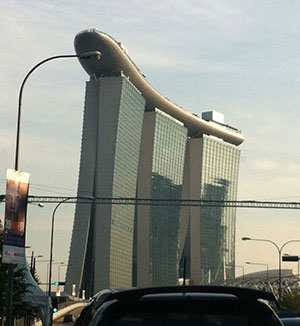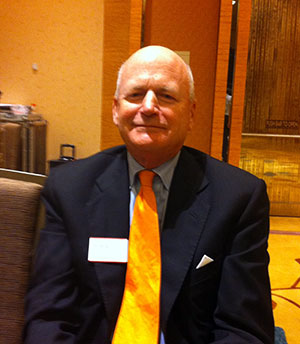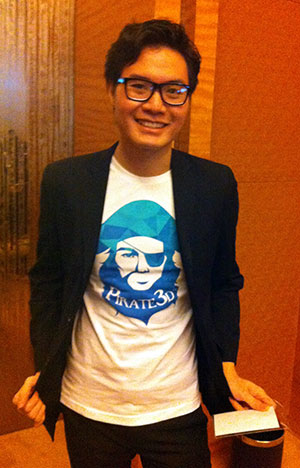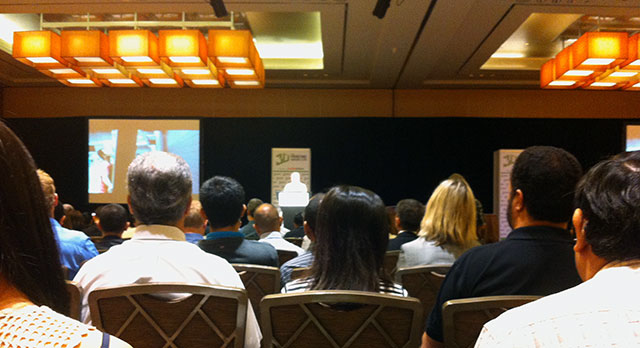
Meeting the team that I have only communicated with virtually in various ways before Monday — a fact that many in Singapore found hilarious when they discovered it — was an enlightening experience. Reassuring though.

For me this conference reiterated that Asia is playing catch up to the West in its understanding and adoption of 3D printing technologies. Commentators and vendors know it, and so did the majority of the people attending the event from the Asia Pacific region when we spoke to them. Incidentally, 18 countries were represented at the show. But, the excitement and anticipation and the full-on eagerness to learn more is as strong as any I have ever seen, maybe more so. People were getting there early, and I don’t just mean one or two, and patiently waiting and chatting until they could get in. And as many, if not more hung around after the close — both days — to talk more, to engage more and to network even more.
It was like a shot of adrenalin.
The shape of the event, for me, was very much like the old-style TCT, which always worked well, with the emphasis very much on the conference — the sharing of information, and a place to really learn and share. The delegates were loving it — they were very, VERY keen. I spoke with designers, government officials, academics and company owners across the two days, as well as people looking to see how 3D printing could enable a new business or a new direction for their current business — all of them were at various stages in their 3D printing education, but all of them wanted to know more and they knew this was the place to find out. I don’t know whether it was nostalgia or the buzz about the place, probably both, but it was a wonderfully inspiring event to be at.
The line up of speakers was a very clever, well-tailored blend of world leaders in the 3D printing world and local experts that had understanding and experience of 3D printing and its current place in the Asia Pacific region.
Ian Gibson, the conference chair and one of Phill Dickens’ cohorts from the University of Nottingham at the very beginning of 3D printing’s historical arc in the early nineties, backed this up too. Ian has spent almost 20 years working with and teaching RP/3D printing at academic institutions in Asia, including in Honk Kong, and more recently in Singapore, where he has been a resident since 2005. Having communicated with Ian at various times during the last 18 years, it was one of my personal highlights to meet him in person. He confirmed how important this event was to the region, particularly in view of it being the first and bringing with it such a high quality programme. He was in a position to know this as he was instrumental in the construction of it together with 3DPI’s own Ari Honka and Eetu Kuneinen, who are also based in Asia, specifically Thailand and Hong Kong.

Apart from the keynotes, the conference ran across two tracks, I got to as many as I could. A few themes did emerge across the conference sessions, notably about the history of the 3D printing industry, usually associated with the individual presenter’s own longevity within said industry, and using this to provide perspective and to manage expectations now and for the future. Avi’s 10 years at the helm of 3D Systems was credited by Ian as he introduced him, and Avi went onto mention the 30 year anniversary of the 1st SLA part, as he did last week. But that was a given. Terry Wohlers, consultant and the industry veteran that has produced the annual Wohlers Report for the last 18 years, boasted 27 years in the industry, While Ian Gibson and Phil Reeves are standing at 20+ years each.
The different historical perspectives were hopefully illuminating for the audience, as in my opinion, it is important for people coming to these technologies fresh to understand how and why we are where we are and the reality of that.
Olaf Diegel, whom it was an absolute delight to finally meet in person too, probably did this the best. He is a natural born presenter, and got the balance just right — referencing the 25 year commercial history of 3D printing and his personal interactions with it for the last 18 years including his transition from prototyping to manufacturing for his guitars as well as being an educator. Olaf was clear when he said mass production is not going anywhere but that the opportunities afforded by 3D printing technology are vast for new and old businesses to make things better and/or unique.
Of course speculation regarding the future varied rather, but without fail it was served with the disclaimer that ultimately, no one knows! And the speculation came with every possible cliché in one form or another — we had the mobile phones, computers and Star Trek Relicators from the pro-consumer futurists. While those that don’t believe in that future went with printing presses and sewing machines! And of course, there were innumerable replays of Barack Obama’s SotU address to promote the role of 3D printing in localized manufacturing developments, topped only by the Yoda image in the 3D printing cliché stakes. Phil Reeves made me laugh, having picked up on the Obama references himself, he showed an image of him looking “slightly” less happy as his government shut down on Tuesday night.
Indeed, Phil drew a couple of gasps from the audience during the panel session, when in his no nonsense way, he swam against the tide saying his vision of the future would see us “moving away from RP machines to manufacture things, and transition to machine tools that are fit for purpose with an additive approach.” This includes integration of robotics and electronics technology. Funnily enough, I think there’s research going on along these lines at Nottingham University!
I was also delighted to finally meet Wim Michiels who is based in Asia for Materialise. Wim is a 14-year veteran of the 3D printing industry and describes himself as “still a student.” I can totally identify with this position, that’s exactly how I feel. His positive take on how and when 3D printing adds value, was balanced by Wim’s take-away message — “don’t over estimate AM.”
So, despite all the positivity, totally valid, I might add, what I did find myself thinking is that today’s rhetoric is still the same as it has been for years — those limitations (accuracy at the entry level, repeatability at all levels, materials, input etc) are all still barriers to adoption — which ever part of the 3D printing spectrum one is looking to engage. The positivity all comes from finding what you CAN do with it — those specific applications where 3D printing works better than any other technology. And there are plenty, and the more people that understand the technology the more applications will emerge. And this will happen as the technologies continue to (slowly) improve and new materials come through R&D, but again, some of us may have said that before — a few times.
Thus the emphasis from the speakers to the audience was generally encouraging — get involved now but with realistic expectations (either with an entry level machine or with a service partner). Find your niche.
Some people from the region already have, to be fair. Hanyang Leong, co-founder of Funbie Studios, is working on building 3D printing communities in Singapore — from the ground up. For him it is about education, sharing information and physical meet-ups. His experience so far has seen him heading into local schools (primary and secondary) as well as meeting with designers and entrepreneurs — all with the aim of propelling invention and innovation, locally. Can’t argue with that.
One of the most inspiring people I met was Ki Chong. Ki, whose family is in Cambodia, had set up a business, Hero Arc, in California. But just days before attending Inside 3D Printing he had packed up, and shipped a Rostock Max 3D printer kit to Cambodia. He and his brother have a vision to bring the potential of 3D printing to a location where it is genuinely needed and will bring value. They are planning on setting up a FabLab in Cambodia with a view to teaching and enabling local people to design and make things they need, when they need them, precisely where they need them. This is the epitome of what 3D printing is best at right now — making a real difference and not trying to change the whole world.
The only less well-attended sessions at the conference was the one dedicated to IP/Copyright/Law. There were two presentations, one from Bill Cass, a US-based lawyer and one from a British lawyer, James Evans, who has been working in Asia for over a decade. To me, once again, this speaks volumes as to where Asia is in its 3D printing journey. To be frank, even after all these years, and knowing how important these issues are/will be, I struggle with them. Probably because there are no clear, fair answers. Faced with lawyers’ opinions on these issues or spending more time with real 3D printers in the expo — it was not surprising, to me at least, that many delegates opted for the latter.

One of the biggest surprises was attending a presentation by Lawrence Schrank, which looked at the future outlook on 3D scanning for 3D printing. Lawrence, based in Thailand, has extensive experience of working with scanning technologies for industrial applications. The greatest enemy of this activity it seems, is the polygon. Citing the history of 3D scanning and the limitations of the polygon he went on to outline a new, more productive way of working with 3D scan data — the Octree — an advanced form of volumetric representation that as and when it comes online will make a huge difference to industrial 3D printing too.
The new Peachy 3D printer (with nearly 4k backers and currently half-way through its KS campaign), was cited in Singapore by more than one person as a potentially radical disruption in the 3D printing industry. At $100, the potential is certainly there, but as with all KS campaigns, we need to see if the reality can match the marketing. I truly hope so.
But, talking of radical disruption, I was introduced to something at the very end of the show that tipped me to overly excited. Yes, it’s another 3D printer, yes, in terms of printing it is probably not that different to what’s around now. But I can’t overstate how different it actually is in every other way because someone — Quinn Karaitiana — has been thinking outside of the box. Quinn was so excited talking about it, my initial skepticism was soon swept aside, first by a picture together with a very animated explanation, and then seeing it in the flesh, so to speak, after being sworn to secrecy. I can’t wait to tell you more!
I was introduced to another really exciting development by Sum Kok Meng — his company is a spin out from the university in Singapore. He and his team are working on developing a silk material for 3D printing — pure silk treated with an epoxy, that will print. I’m planning on a separate post on this to explain more.
To sum up, excitement truly was the order of the day(s) — it was palpable and that is what I will take away from this event – the vibrancy of the Asian market, condensed into the Singapore region. I had been told Singapore was a good place to start in Asia – it really was.




